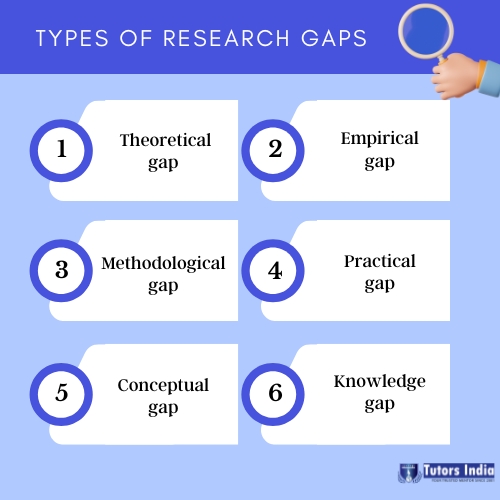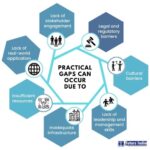What are the different types of research gaps in the literature review?
What is the research gap in literature review?
- The purpose of a literature review is not only to examine the past available literature but also identifying gaps in the literature.
- According to Robinson et al., a research gap arises ‘when the capability of the reviewer to draw conclusions from existing studies is limited.’ A research gap forms a starting point for conducting further research.
- While a research gap in literature review can be considered an ‘output’ of a literature review, it can also be considered an ‘input’ that motivates further research (Bloch, 2015).
One needs careful planning and organisation for writing a research gap. For more guidance on writing one, check out our study guide on How to write a research gap for a literature review?
Types of research gaps
Research gaps can also arise due to contradictory findings, changing trends and unanswered questions. Classification of research gaps facilitates convenience and can be classified as follows:-

1.Theoretical gap: A gap in existing theories and models in the field that has not been effectively addressed is known as a theoretical gap or theory application void gap.
It can be identified through a literature review, where the researcher examines the existing literature on the research topic and identifies inconsistencies, limitations, and gaps in the research.
Example: In economics and finance, a theoretical gap arises when there is a lack of understanding of the factors that lead to financial bubbles, characterised by periods of a stark increase in prices followed by a decline.
2.Empirical gap: The term “empirical gap” refers to the missing or undiscovered components of a phenomenon that can be addressed through empirical research. When the available data or empirical research is unable to answer specific research questions, a gap results, known as an empirical gap or empirical void gap.
For instance, a study conducted by Goh and Lee (2020) on the impact of social media on consumer behaviour found that there is a lack of research on the role of social media influencers in shaping consumer behaviour for availing services and purchasing products. This can be considered an empirical gap that can be addressed through new empirical research.
An example of an empirical gap is understanding the environmental, social and governance (ESG) factors and financial performance. Some studies reveal a positive connection between strong ESG practices and financial performance, whereas others find no or even a negative association.
For guidance on empirical research in economics dissertation, check out our blog on How to build empirical modelling for economic dissertation research.
3.Methodological gap: A methodological gap, or method and research design gap, is a gap in the research procedures and techniques employed in previous studies that may affect the precision and reliability of the findings. This can impair the accuracy of analysis, limit the scope of research, and hinder the development of robust models or solutions in the field of finance.
Sometimes, researchers conducting research in finance may lack the necessary data, leading to methodological research gaps. Limited data hinders the ability to conduct further research, leading to a methodological gap.
4.Practical gap: Practical gap arises when there is a discrepancy between theory and practice, where there is a necessity to conduct further research to address this gap and improve the application of the theoretical findings into practice. A practical gap is also called Practical-Knowledge Gap or Action-Knowledge-Conflict Gap.
An example of a practical gap in finance is the access and utilisation of financial education programs, workshops and online resources that can help individuals to gain and apply knowledge to manage their finances effectively. This gap occurs since financial literacy varies between populations.
5.Conceptual gap: Conceptual gaps occur when there is inconsistency or ambiguity in a concept’s definition, interpretation, or application, resulting in confusion and misunderstanding. Conceptual gaps lead to inconsistent or unclear definitions and interpretations.
For instance, there is a conceptual gap in building frameworks that explicitly recognise the crucial role of managing stakeholders and creating value for long-term financial performance and sustainable growth.
Another example of a conceptual gap is the future applications of financial instruments, where the definition of financial instruments was not clear till Brown gave one for understanding.
6.Knowledge gap: A knowledge gap is the difference between what is known and what needs to be known about a specific topic. A knowledge gap can occur for various reasons, including insufficient or incomplete information, contradictory information, limited research, and outdated information.
To identify a knowledge gap, researchers must extensively examine the available literature and identify areas where additional study is required. They can also conduct surveys or interviews to examine the general public’s or specialists’ knowledge and awareness of a specific problem. Addressing a knowledge gap leads to advancing knowledge in a particular field and gives rise to new concepts, theories or practices.
An example of a knowledge gap is the effect of emerging financial technologies on traditional banking systems. There is a greater risk for cybersecurity, like identity theft, data breaches and cyber threats, and researchers can study the risks of financial technologies and offer management strategies for customers and financial institutions (Kavuri, 2019).
Conclusion
A research gap occurs when a researcher is unable to draw conclusions from existing literature. Identifying gaps in literature is crucial for a literature review. There are various types of research gaps that include theoretical gas, empirical gaps, methodological gaps, practical gaps, conceptual gaps and knowledge gaps. Addressing these types of research gaps can significantly add to the existing body of knowledge and lead to knowledge advancement in a given field.
We are a team of professional academic writers who assist Master’s students in writing a literature review from various specialisations. We guide students in writing a literature review dissertation and coursework, offer study guides and samples and ensure that the students comply with their university guidelines. We also offer editing and proofreading services, which ensure the literature review is error-free and plagiarism-free. In addition, we offer numerous examples that will help students write a well-structured literature review.
To learn more about how a literature review is written in various disciplines, check out our literature review examples.
References:
Müller-Bloch, C., & Kranz, J. (2015). A framework for rigorously identifying research gaps in qualitative literature reviews.
Kavuri, Anil Savio and Milne, Alistair K. L., Fintech and the Future of Financial Services: What Are the Research Gaps? (February 13, 2019). CAMA Working Paper No. 18/2019

 Previous Post
Previous Post Next Post
Next Post